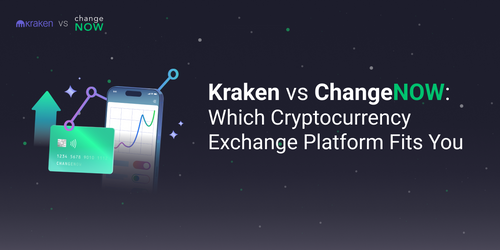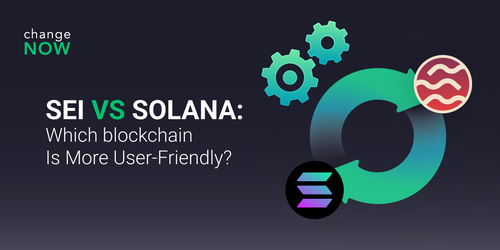NEAR Protocol vs. Solana: Battle of Scalable Blockchains

Let’s dive into two super interesting blockchains: NEAR Protocol and Solana. Both are lightning fast, eco-friendly, and developer-focused. We’ll break down how they compare in terms of scalability, roadmaps, and the cherry on top — how you can easily swap these tokens on ChangeNOW!
NEAR Protocol: A Developer’s Dream
NEAR Protocol is built with scalability and user/developer experience at its core. It employs Nightshade Sharding, a fancy way of splitting the blockchain into shards to handle loads of transactions simultaneously. NEAR simplifies dApp development, making blockchain accessible to everyone.
- Token: $NEAR
- Consensus Mechanism: Thresholded Proof of Stake (TPoS) — ensuring eco-friendliness and decentralization.
- Roadmap: The NEAR Protocol roadmap for late 2024 focuses on optimizing stateless validation with improvements like reducing gas costs for storage and introducing resharding to scale the network dynamically. Future upgrades, planned for 2025, include a transaction priority fee system, dynamic resharding, and exploring a leaderless consensus to boost performance even when some nodes are offline.
Solana: Speed and Scalability at its Core
Solana stands out with its Proof of History (PoH), which timestamps transactions for faster processing. It’s one of the fastest blockchains in the world, designed for high throughput without compromising decentralization.- Token: $SOL
- Consensus Mechanism: Proof of Stake (PoS) + Proof of History (PoH) — making Solana both fast and scalable.
- Roadmap: Solana's future upgrades focus on improving network stability, expanding its developer ecosystem, and enhancing DeFi features.
NEAR vs. Solana: Head-to-Head
| Feature | NEAR Protocol | Solana |
|---|---|---|
| Token | $NEAR | $SOL |
| Consensus Mechanism | Thresholded Proof of Stake (TPoS) | Proof of Stake + Proof of History (PoS + PoH) |
| Architecture | Sharding (Nightshade) | Single-layer with Proof of History |
| TPS | High (with an average of 2,500 to 3,000 TPS, theoretically scaling to 100,000 TPS) | High (with an average of 2,700 TPS, theoretically reaching up to 65,000 TPS) |
| Fees | Low, but fluctuates | One of the lowest |
| Focus | Developer experience, dApps | High-speed DeFi, scalability |
Detailed Breakdown: Diving Deeper
Scalability
NEAR’s Nightshade Sharding helps break up the blockchain, so it can process lots of transactions in parallel. Solana’s Proof of History ensures fast transaction processing by using historical timestamps. While NEAR excels in handling high loads through sharding, Solana’s PoH gives it an edge in terms of raw transaction speed.
Speed & Fees
Both blockchains are incredibly fast, but Solana outpaces NEAR with transaction finality times of less than 1 second, while NEAR - about 2 seconds. We checked the latest transactions and the average fee is around $0.00196 for Solana, whereas NEAR’s fees are around $0.00448.
Developer Experience
NEAR has a strong focus on making blockchain development accessible to everyone with easy-to-use tools. Developers can choose between JavaScript and Rust throughout the development cycle, and while any language that compiles to Wasm can theoretically be used for developing NEAR smart contracts, a user-friendly experience requires a library to wrap low-level runtime APIs and provide high-level functionalities, with future support for more languages expected through contributions from the wider community, not just NEAR itself.
Solana, while highly performant, can be more complex to develop on due to its cutting-edge technology, but it provides powerful tools for those building DeFi applications. Solana programs are primarily written in Rust, with support for C/C++, and community-driven efforts are enabling other languages like Python through Seahorse, which wraps the Rust-based Anchor framework.
Use Cases
NEAR has a diverse ecosystem focusing on various use cases, including DeFi, NFTs, DAOs. As for Solana, it has built a strong presence in DeFi, dApps, DEX, with a rapidly expanding developer and user base.
Common Ground: NEAR & Solana
Even though they use different tech under the hood, NEAR and Solana share some key similarities:
- Eco-friendly: Both run on Proof-of-Stake (or its variations), making them far more energy-efficient than Proof-of-Work chains like Bitcoin.
- Blazing Fast: Speed is crucial, and both NEAR and Solana deliver near-instant transaction confirmations.
- Low Fees: Both blockchains are known for keeping transaction costs wallet-friendly — low fees are a big draw for developers and users alike.
- Cross-chain: Both projects are working toward cross-chain integration, allowing for smoother transitions between different blockchains and expanding their reach.
How to Support NEAR and Solana
Want to support these blockchains by swapping their tokens? You can easily exchange between $NEAR and $SOL on ChangeNOW! The process is super simple:
- Go to ChangeNOW’s website.
- Select the token you want to swap (say, NEAR).
- Choose your destination token (SOL).
- Enter your wallet addresses, hit "Exchange," and boom – done!
Not only do you get a fast and secure swap, but ChangeNOW ensures that you get the best exchange rates with no hidden fees.
FAQ
1. Which blockchain is faster: NEAR or Solana?
Both are fast, but Solana has an edge due to its Proof of History (PoH) mechanism, which allows for even faster transaction speeds than NEAR's sharding.
2. Which blockchain has lower fees?
Solana typically has lower fees, often just a fraction of a cent, while NEAR’s fees are also low but can vary slightly depending on network usage.
3. Are both blockchains eco-friendly?
Yes! Both NEAR and Solana use Proof-of-Stake variations, making them much more energy-efficient than Proof-of-Work blockchains.
4. Can I use both chains for DeFi?
Absolutely. Solana is highly DeFi-focused, but NEAR is also growing its DeFi ecosystem with more dApps being developed.
5. How can I swap NEAR for Solana?
You can easily swap NEAR for Solana (or vice versa, or any of this tokens for 1000+ other) using ChangeNOW, a simple and secure crypto exchange platform with no hidden fees.
And there you have it! A breakdown of NEAR Protocol and Solana, what makes them unique, and how to support them through token exchanges on ChangeNOW. Whether you're building the next dApp on NEAR or exploring DeFi on Solana, both of these blockchains offer exciting opportunities in the crypto space!



